As Chanukah is just around the corner, I thought it would be interesting to look at the origins of the forerunner of the eight branched candelabra or chanukiah: the menorah. The menorah made its first appearance in the book of Exodus where after G-d commands Moses to climb Mount Sinai he tells him “You shall make a lampstand of pure gold…Note well, and follow the patterns…that are being shown you on the mountain” (Chapter 25 31-40).
Unfortunately we all know what happened to the original blueprints Moses received and the sketch of the original menorah is lost to us. The description given to Moses is of a six branched candelabra with seven flames. Several different interpretations have been suggested to explain its symbolism: the burning bush seen by Moses on Mount Horev, the seven days of the week or of creation with Shabbat in the centre, the branches of human knowledge, to name but a few.
The original menorah was made for using in the Tabernacle in the desert, but we know from the second book of Chronicles that Solomon built ten golden menorahs for use in his temple. Jeremiah describes their fate as part of the loot that Nebuzaradan, the Chaldean chief of the guards, takes with him to Babylon. We don’t know if they were brought back with the returnees as part of the “vessels” given to Sheshbazar when the exiles return as they are not specifically enumerated by the scribe Ezra in his description of the items given back to the people.
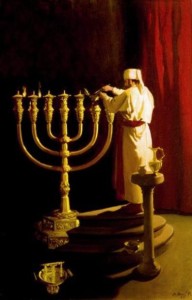 The exact function of the menorah in the temple is unclear as is whether all of the flames were kindled every day. We do know that the priests lit the flames in the evening and cleaned the menorah the following morning, replacing the wicks and refilling the cups with purest quality olive oil. The miracle of the Chanukah story took place in the year 164 BCE when the anti – Semitic Greek ruler, Antiochus IV tried to outlaw Judaism and defiled the temple dedicating it to Zeus and sacrificing pigs on the altar. His actions led to outrage amongst the traditionalist Jews who were not only fighting against this aggressive attack on their religion by the Greeks, but also against the Hellenized Jews in their midst. Led by Judah HaMacabee of the Hasmonean dynasty, a guerilla war ensued against the Greeks. The king’s sudden death allowed the traditionalists to gain control and when they made their way into the temple, they found only enough undefiled oil to allow the menorah to burn for one day. They hastily sent forces to the Galilee to bring more supplies of pure oil. It took eight days before they returned, during which time the light of the menorah miraculously remained burning. It is for that reason we use an eight branched menorah or “chanukiya” to celebrate the festival, with the ninth flame used to light the other eight.
The exact function of the menorah in the temple is unclear as is whether all of the flames were kindled every day. We do know that the priests lit the flames in the evening and cleaned the menorah the following morning, replacing the wicks and refilling the cups with purest quality olive oil. The miracle of the Chanukah story took place in the year 164 BCE when the anti – Semitic Greek ruler, Antiochus IV tried to outlaw Judaism and defiled the temple dedicating it to Zeus and sacrificing pigs on the altar. His actions led to outrage amongst the traditionalist Jews who were not only fighting against this aggressive attack on their religion by the Greeks, but also against the Hellenized Jews in their midst. Led by Judah HaMacabee of the Hasmonean dynasty, a guerilla war ensued against the Greeks. The king’s sudden death allowed the traditionalists to gain control and when they made their way into the temple, they found only enough undefiled oil to allow the menorah to burn for one day. They hastily sent forces to the Galilee to bring more supplies of pure oil. It took eight days before they returned, during which time the light of the menorah miraculously remained burning. It is for that reason we use an eight branched menorah or “chanukiya” to celebrate the festival, with the ninth flame used to light the other eight.
It is interesting to note that the two post-biblical festivals which were incorporated into the Jewish calendar, namely Chanuka and Purim, celebrate our victory over those who wished to wipe us out. However the focus of both these festivals is not on the fighting and bloodshed, but the miracle of our survival. The military victory of Chanuka is de-emphasised in favour of the miracle of the oil and the rededication of the temple, and on Purim we stress charity and gifts to the poor. One of the ironies of Chanuka is that the civil war that erupted between the Jews was in protest against the Hellenization of the Jews. In modern times, as a direct result of the commercialism of “the Christmas season,” in many places Chanuka has turned into the most assimilated holiday we have!
In Herod’s temple we know there were also menorahs thanks to the writings of Josephus. He relates in his book “The Jewish War” how a priest named Phineas handed them over to the Romans. Legend has it they were triumphantly displayed during the victorious Roman procession into Rome together with other treasures of the temple. What happened to them after that is open to much speculation. Many people believe they are located in the storerooms in the basement of the Vatican and various requests over the years by Israel’s chief rabbis and members of the Knesset for their return have gone unanswered.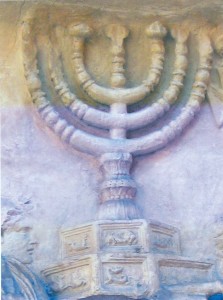
The one thing we know for sure, is that a relief of the Temple menorah is depicted on the Arch of Titus in Rome. This first century victory monument built by his brother, Domitian, commemorates Titus and his father Vespasian’s successful campaign over the Jews in Palestine. So maybe this ought to be the definitive description of its appearance?
In the Old City of Jerusalem there is a model of the menorah built by the Temple Institute, who actively encourage the building of the third temple on the Temple Mount. In accordance with their mission they create ritual objects to be used in this temple, basing their construction on both the biblical texts and descriptions in the Mishna (the codification of the Jewish Oral Law, which is believed to originate in the time of Moses). Their version of the menorah, which can be seen in a plaza overlooking the Western Wall, whilst similar to that depicted in Rome, is not identical.
Another interpretation of the menorah was actually found very close by in the Jewish Quarter. It appears as graffiti on the wall of a house believed to have belonged to one of the priests who served in the second temple. It seems safe to assume that the version of the menorah that is etched on the wall would be a true likeness of what appeared in the temple. It is very different to the other two, featuring a triangular base and straight branches attached to a central stem.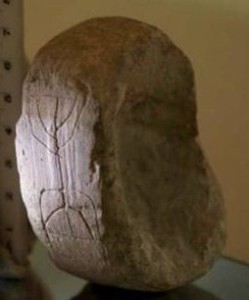
A not dissimilar drawing was found in the area of the City of David. It is a simple sketch inscribed onto a stone that was found alongside the pilgrim path that led up to the temple. Perhaps a visitor wanted to record his impression for posterity and his souvenir fell out of his pocket?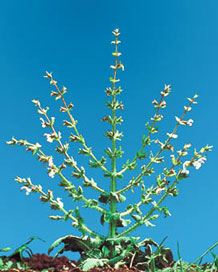
An alternate explanation, is that the nature-suffused imagery in the description of the original menorah in the book of Exodus, which mentions flowers and calyxes, almonds and branches, is actually reminiscent of a local plant. Dr Ephraim and Hannah Reuveni, the founders of Neot Kedumim, a biblical nature reserve, were so struck by the botanical references that they inaugurated a search for indigenous plants that fitted the biblical design. Their efforts led them to the sage family, particularly a genus called “Salvia”, which is also a fragrant variety. The combination of its form symbolizing the light of the menorah and its perfume, reminiscent of the incense in the temple, captivated their imagination and they posited that maybe this was the original prototype. It seems we shall never know for sure exactly how that first menorah looked.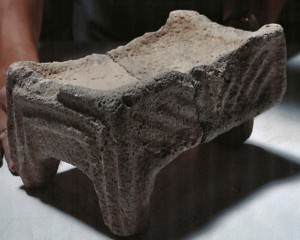
The Samaritans, whose traditions rely heavily on the biblical text, frequently depict the menorah in their art. Their version has curved branches with knobs and flowers as mentioned in the description in Exodus. However another discovery in the early Davidic city of Qeiyafa is of an interesting stone object. This personal altar has been dated to the tenth century BCE and incised on the side of it is a menorah with straight branches. What is mind blowing about this find is that it predates Solomon’s temple by about forty years!
